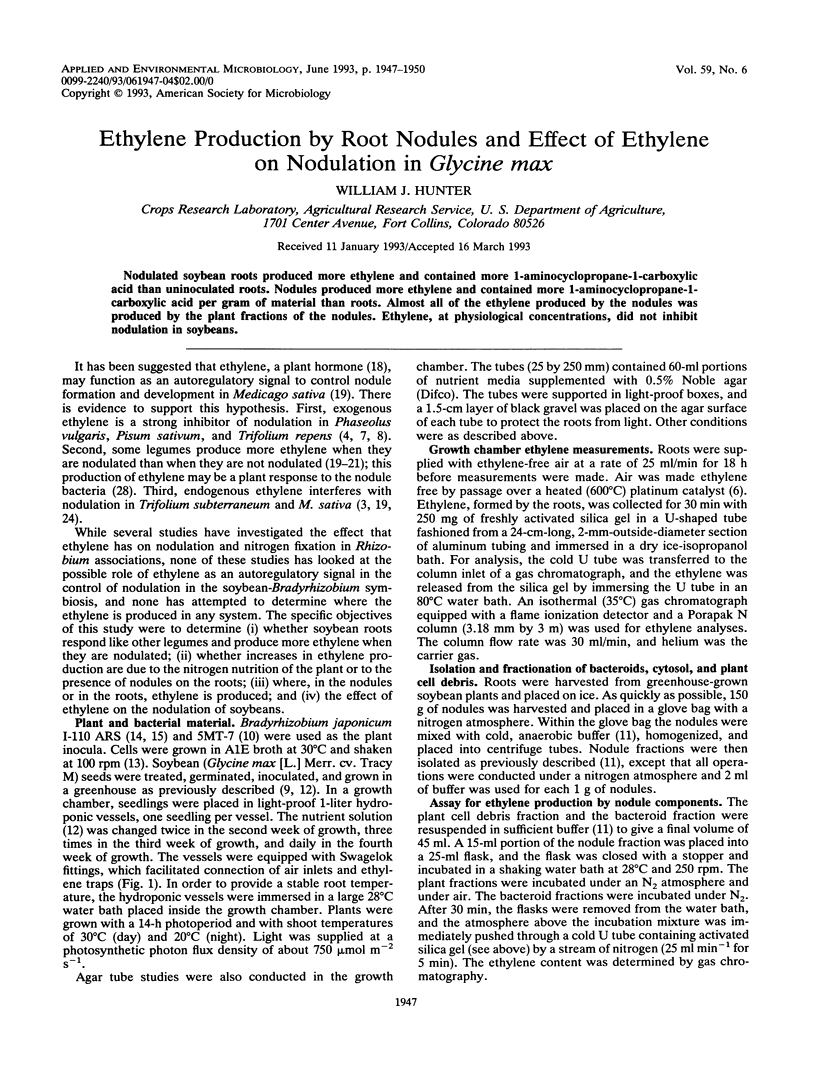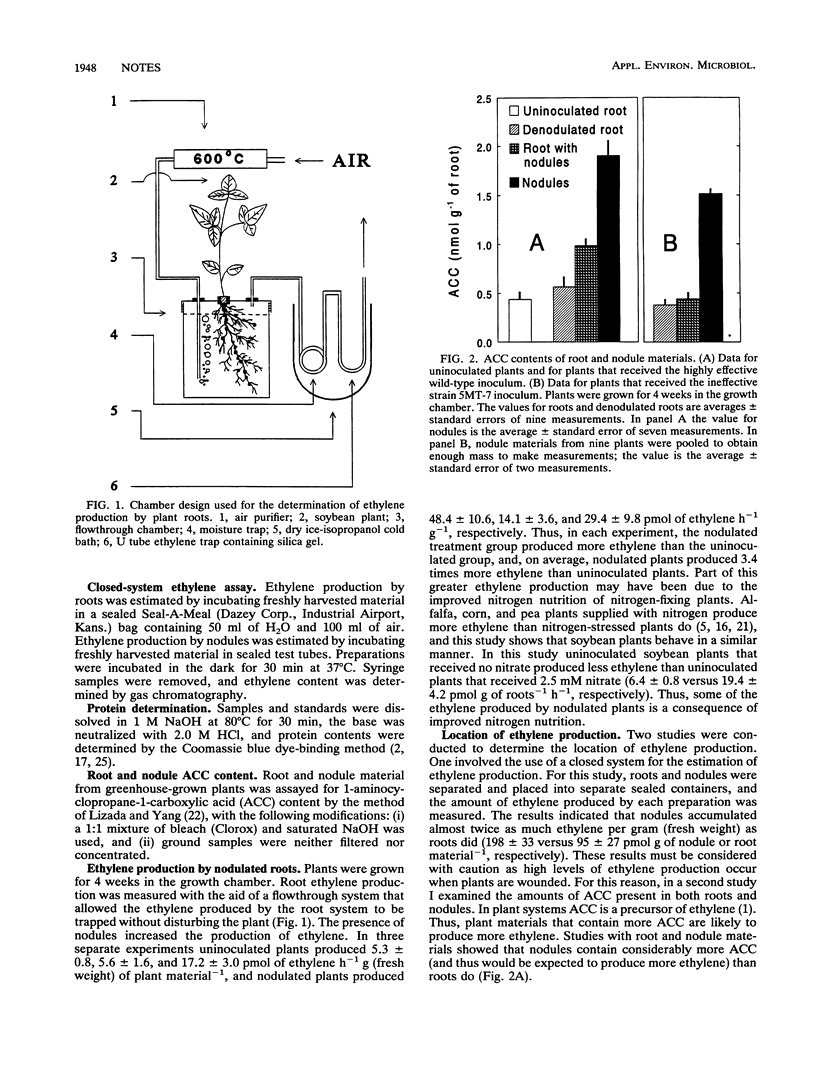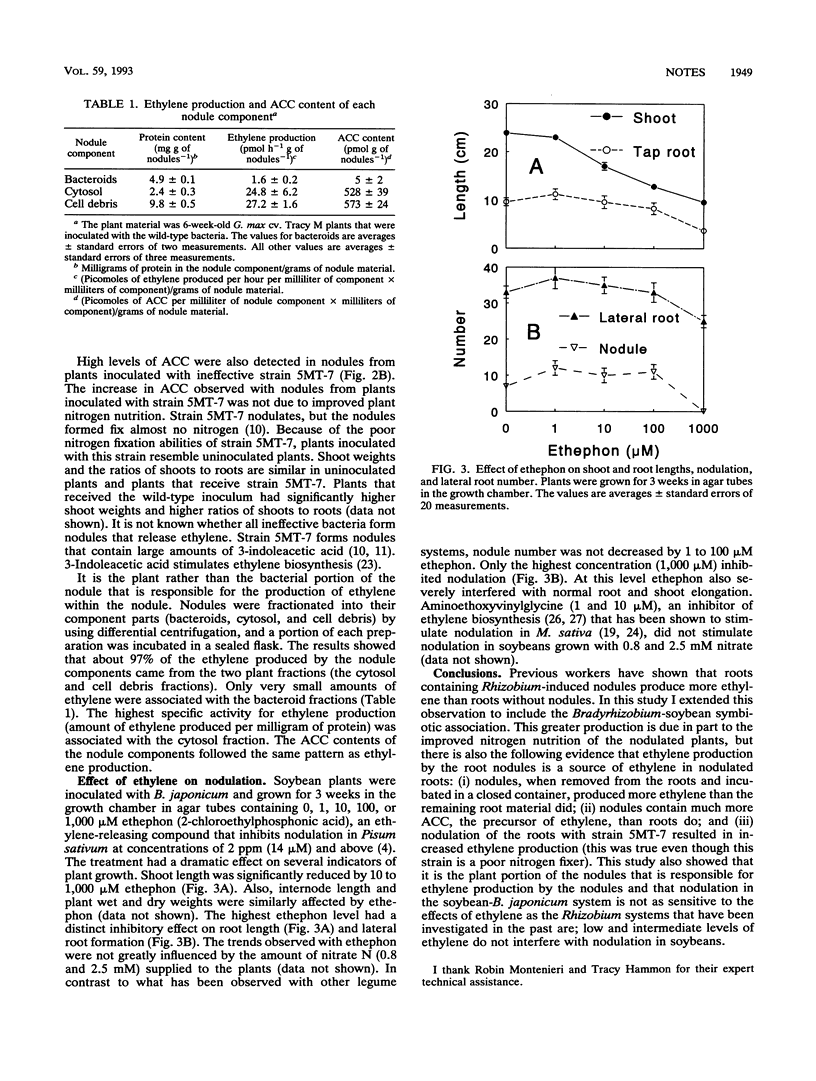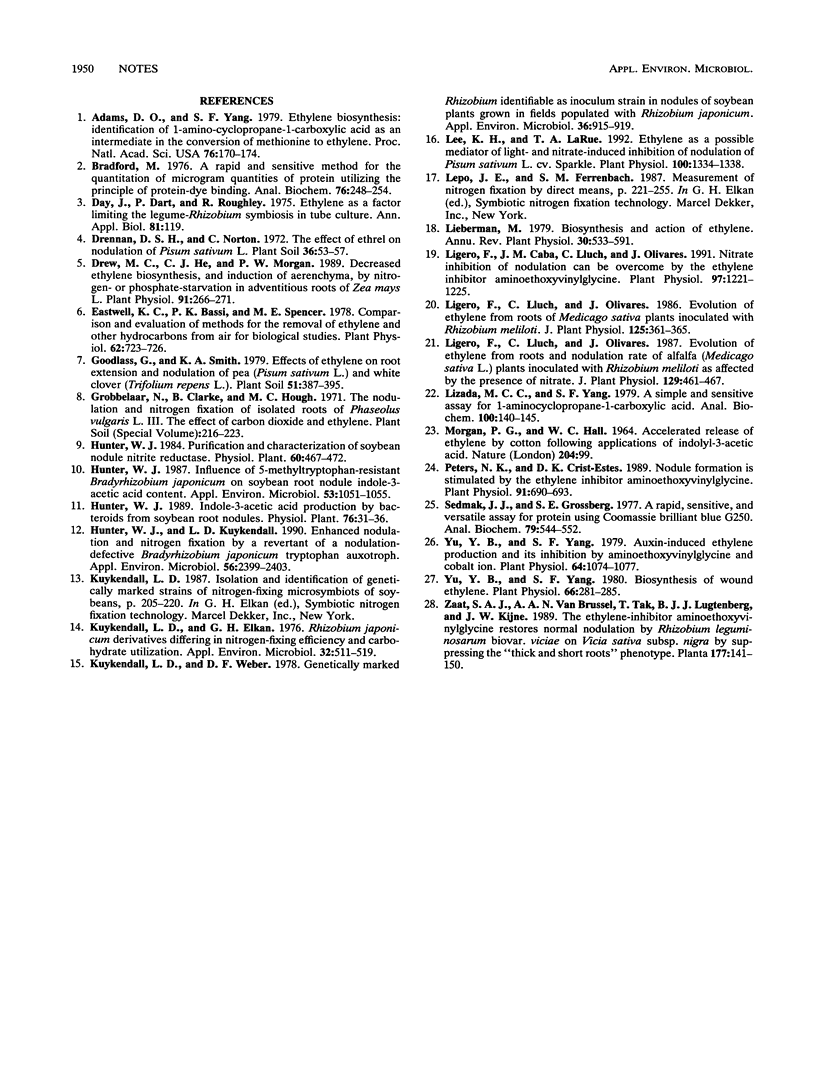Abstract
Nodulated soybean roots produced more ethylene and contained more 1-aminocyclopropane-1-carboxylic acid than uninoculated roots. Nodules produced more ethylene and contained more 1-aminocyclopropane-1-carboxylic acid per gram of material than roots. Almost all of the ethylene produced by the nodules was produced by the plant fractions of the nodules. Ethylene, at physiological concentrations, did not inhibit nodulation in soybeans.
Full text
PDF



Selected References
These references are in PubMed. This may not be the complete list of references from this article.
- Adams D. O., Yang S. F. Ethylene biosynthesis: Identification of 1-aminocyclopropane-1-carboxylic acid as an intermediate in the conversion of methionine to ethylene. Proc Natl Acad Sci U S A. 1979 Jan;76(1):170–174. doi: 10.1073/pnas.76.1.170. [DOI] [PMC free article] [PubMed] [Google Scholar]
- Bradford M. M. A rapid and sensitive method for the quantitation of microgram quantities of protein utilizing the principle of protein-dye binding. Anal Biochem. 1976 May 7;72:248–254. doi: 10.1006/abio.1976.9999. [DOI] [PubMed] [Google Scholar]
- CRANMORE D., ALPEN E. L. CHROMOSOMES OF THE DOMESTIC CAT. Nature. 1964 Oct 3;204:99–100. doi: 10.1038/204099a0. [DOI] [PubMed] [Google Scholar]
- Drew M. C., He C. J., Morgan P. W. Decreased Ethylene Biosynthesis, and Induction of Aerenchyma, by Nitrogen- or Phosphate-Starvation in Adventitious Roots of Zea mays L. Plant Physiol. 1989 Sep;91(1):266–271. doi: 10.1104/pp.91.1.266. [DOI] [PMC free article] [PubMed] [Google Scholar]
- Eastwell K. C., Bassi P. K., Spencer M. E. Comparison and evaluation methods for the removal of ethylene and other hydrocarbons from air for biological studies. Plant Physiol. 1978 Nov;62(5):723–726. doi: 10.1104/pp.62.5.723. [DOI] [PMC free article] [PubMed] [Google Scholar]
- Hunter W. J. Influence of 5-Methyltryptophan-Resistant Bradyrhizobium japonicum on Soybean Root Nodule Indole-3-Acetic Acid Content. Appl Environ Microbiol. 1987 May;53(5):1051–1055. doi: 10.1128/aem.53.5.1051-1055.1987. [DOI] [PMC free article] [PubMed] [Google Scholar]
- Hunter William J., Kuykendall L. David. Enhanced Nodulation and Nitrogen Fixation by a Revertant of a Nodulation-Defective Bradyrhizobium japonicum Tryptophan Auxotroph. Appl Environ Microbiol. 1990 Aug;56(8):2399–2403. doi: 10.1128/aem.56.8.2399-2403.1990. [DOI] [PMC free article] [PubMed] [Google Scholar]
- Kuykendall L. D., Elkan G. H. Rhizobium japonicum derivatives differing in nitrogen-fixing efficiency and carbohydrate utilization. Appl Environ Microbiol. 1976 Oct;32(4):511–519. doi: 10.1128/aem.32.4.511-519.1976. [DOI] [PMC free article] [PubMed] [Google Scholar]
- Kuykendall L. D., Weber D. F. Genetically marked Rhizobium identifiable as inoculum strain in nodules of soybean plants grown in fields populated with Rhizobium japonicum. Appl Environ Microbiol. 1978 Dec;36(6):915–919. doi: 10.1128/aem.36.6.915-919.1978. [DOI] [PMC free article] [PubMed] [Google Scholar]
- Lee K. H., Larue T. A. Ethylene as a Possible Mediator of Light- and Nitrate-Induced Inhibition of Nodulation of Pisum sativum L. cv Sparkle. Plant Physiol. 1992 Nov;100(3):1334–1338. doi: 10.1104/pp.100.3.1334. [DOI] [PMC free article] [PubMed] [Google Scholar]
- Ligero F., Caba J. M., Lluch C., Olivares J. Nitrate inhibition of nodulation can be overcome by the ethylene inhibitor aminoethoxyvinylglycine. Plant Physiol. 1991 Nov;97(3):1221–1225. doi: 10.1104/pp.97.3.1221. [DOI] [PMC free article] [PubMed] [Google Scholar]
- Lizada M. C., Yang S. F. A simple and sensitive assay for 1-aminocyclopropane-1-carboxylic acid. Anal Biochem. 1979 Nov 15;100(1):140–145. doi: 10.1016/0003-2697(79)90123-4. [DOI] [PubMed] [Google Scholar]
- Peters N. K., Crist-Estes D. K. Nodule formation is stimulated by the ethylene inhibitor aminoethoxyvinylglycine. Plant Physiol. 1989 Oct;91(2):690–693. doi: 10.1104/pp.91.2.690. [DOI] [PMC free article] [PubMed] [Google Scholar]
- Sedmak J. J., Grossberg S. E. A rapid, sensitive, and versatile assay for protein using Coomassie brilliant blue G250. Anal Biochem. 1977 May 1;79(1-2):544–552. doi: 10.1016/0003-2697(77)90428-6. [DOI] [PubMed] [Google Scholar]
- Yu Y. B., Yang S. F. Auxin-induced Ethylene Production and Its Inhibition by Aminoethyoxyvinylglycine and Cobalt Ion. Plant Physiol. 1979 Dec;64(6):1074–1077. doi: 10.1104/pp.64.6.1074. [DOI] [PMC free article] [PubMed] [Google Scholar]
- Yu Y. B., Yang S. F. Biosynthesis of wound ethylene. Plant Physiol. 1980 Aug;66(2):281–285. doi: 10.1104/pp.66.2.281. [DOI] [PMC free article] [PubMed] [Google Scholar]
- de Bont J. A. Oxidation of ethylene by bacteria. Ann Appl Biol. 1975 Sep;81(1):119–121. doi: 10.1111/j.1744-7348.1975.tb00524.x. [DOI] [PubMed] [Google Scholar]


